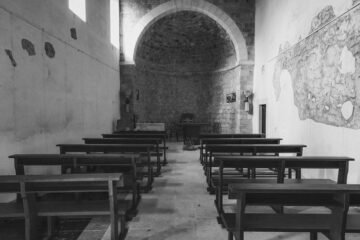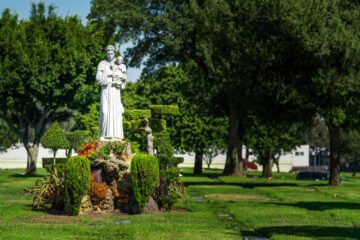Learn All About Catholic Cemeteries
Catholic Ceremonies
Need Help Finding The Right Catholic Cemetery?
- EASY TO USE SEARCH
- LOCAL RESULTS
- ONLY CATHOLIC CEMETERIES
Find Catholic Cemeteries Near You - Search By State
Frequently Asked Questions About Catholic Cemeteries
Difference between Catholic Cemetery and non-Catholic
- Catholic cemeteries are sanctified grounds, deeply rooted in the Catholic faith and its teachings. They are not just places where the deceased are laid to rest, but are sacred spaces where the spiritual journey continues in the presence of God. The consecration of these grounds is a reflection of the belief in the sanctity of the body, the resurrection, and the eternal soul.
Catholic in non-Catholic Cemetery
Yes, a Catholic can be buried in any cemetery. The Catholic Church allows for burials in non-Catholic cemeteries, especially when a Catholic cemetery is not available or if there are other family considerations. However, it's encouraged to have the gravesite blessed by a Catholic priest to align with religious traditions.Direction of cemetery
In Catholic tradition, graves were historically oriented eastward, symbolizing the resurrection and Christ's return, a practice rooted in deep symbolic significance. However, in modern times, this is no longer a strict requirement, due to practical considerations and changes in cemetery design. The Catholic Church now allows flexibility in the orientation of graves, understanding that the essence of its sacred traditions transcends physical direction. This adaptation reflects the Church's respect for its heritage while accommodating contemporary realities.Non-Catholics in Catholic Cemetery
Yes, non-Catholics can be buried in Catholic cemeteries. This practice is often permitted to accommodate interfaith families and honor specific wishes of the deceased. However, individual cemetery policies and diocesan guidelines may vary.Traditional Rituals
Traditional Catholic burial traditions encompass several key rituals. The Vigil, or wake, involves communal prayer and recitation of the Rosary. The Funeral Mass, a central aspect, includes Scriptural readings, hymns, and the Eucharist, focusing on the resurrection hope. Finally, the Committal at the burial site concludes the rites, followed by ongoing memorial practices like annual remembrances and Masses for the deceased's soul.Churches with graves inside
- Some Catholic churches have graves inside due to historical and religious reasons. Traditionally, burial within the church, especially near the altar, was considered a great honor, symbolizing closeness to God and the church community. This practice was more common in earlier centuries, especially for high-ranking church officials, local dignitaries, and benefactors. Over time, as space became limited and public health concerns grew, this practice decreased, leading to the establishment of separate cemeteries. Today, these in-church burials stand as historical reminders of past customs and the enduring reverence for the church as a sacred final resting place.
Perpetual Care Cemeteries
Perpetual care cemeteries are burial grounds where a portion of the cost of the burial plot is allocated to an endowment fund. This fund is specifically designed to ensure ongoing maintenance and upkeep of the cemetery grounds, including landscaping, repairs, and general care. The concept of perpetual care ensures that the cemetery remains a dignified, respectful, and well-maintained resting place for generations to come. It reflects a commitment to honoring the memory of those interred there, providing peace of mind to families that the final resting place of their loved ones will be preserved indefinitely.Catholic Symbolism in Cemeteries
- Crosses: The most prominent symbol, representing Christ's sacrifice and the hope of resurrection. 2. Statues of Saints: Serving as reminders of the virtues and the spiritual guidance they offer. 3. Angels: Symbolizing guardianship and the link between heaven and earth. 4. Inscriptions: Often include biblical verses or prayers, expressing faith and hope in eternal life. 5. IHS Christogram: A monogram of Jesus Christ, signifying a direct connection to the faith. 6. Doves: Representing peace and the Holy Spirit. 7. Lamb: A symbol of innocence, often used on children's graves. 8. Skulls or Skeletons: Reminders of mortality and the temporal nature of earthly life.
Cemetery rules
Catholic cemeteries enforce specific regulations to ensure these sacred spaces remain dignified and respectful environments for prayer and remembrance. These rules typically permit decorations such as fresh or artificial flowers in self-draining vases, solar or battery-operated vigil lights, and durable material religious statues, while prohibiting items like glass decorations, fencing, toys, and balloons, which might pose safety hazards or detract from the cemetery's sanctity. Additionally, to maintain the grounds' beauty and order, cemeteries conduct scheduled clean-ups, removing non-compliant items. These guidelines are intended to honor the departed and provide a consoling space for visitors, emphasizing the importance of adhering to these regulations to preserve the sacredness and aesthetic integrity of Catholic cemeteries.Find Catholic Cemeteries Near You
- in



